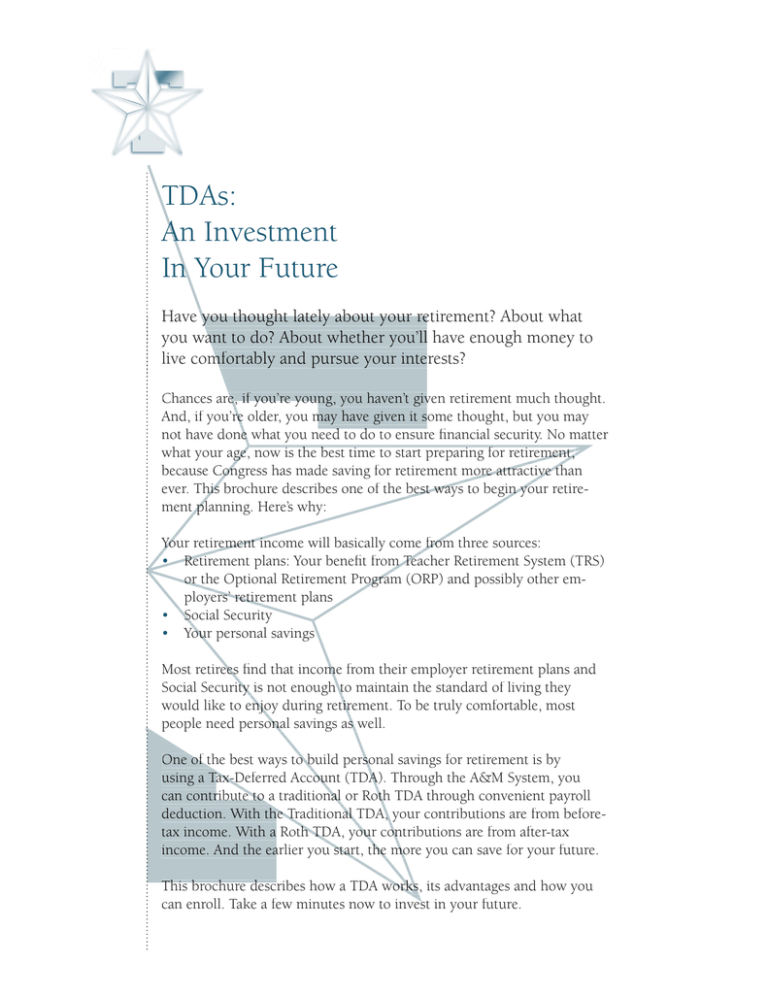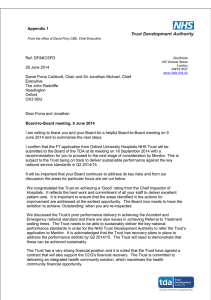Have you thought lately about your retirement? About what
advertisement

TDAs: An Investment In Your Future Have you thought lately about your retirement? About what you want to do? About whether you’ll have enough money to live comfortably and pursue your interests? Chances are, if you’re young, you haven’t given retirement much thought. And, if you’re older, you may have given it some thought, but you may not have done what you need to do to ensure financial security. No matter what your age, now is the best time to start preparing for retirement, because Congress has made saving for retirement more attractive than ever. This brochure describes one of the best ways to begin your retirement planning. Here’s why: Your retirement income will basically come from three sources: • Retirement plans: Your benefit from Teacher Retirement System (TRS) or the Optional Retirement Program (ORP) and possibly other employers’ retirement plans • Social Security • Your personal savings Most retirees find that income from their employer retirement plans and Social Security is not enough to maintain the standard of living they would like to enjoy during retirement. To be truly comfortable, most people need personal savings as well. One of the best ways to build personal savings for retirement is by using a Tax-Deferred Account (TDA). Through the A&M System, you can contribute to a traditional or Roth TDA through convenient payroll deduction. With the Traditional TDA, your contributions are from beforetax income. With a Roth TDA, your contributions are from after-tax income. And the earlier you start, the more you can save for your future. This brochure describes how a TDA works, its advantages and how you can enroll. Take a few minutes now to invest in your future. What is a Tax-Deferred Account? A Tax-Deferred Account (TDA) is a way for you to save for retirement. All A&M System employees, including wage employees and graduate students, can use the traditional and/or Roth TDA to lower current federal income tax liability or future federal tax liability upon retirement. When you enroll in a traditional or Roth TDA, you agree to have a specific amount or percentage deducted from each of your paychecks and sent to the investment vendor you choose from the A&M System list of active vendors. With a traditional TDA, your contribution is deducted from your pay before federal income tax is calculated, so you do not pay current income tax on your contributions and the money does not show up on your W-2 form as income. Likewise, you do not pay current income tax on the investment earnings on your TDA savings. With a Roth TDA, your contribution is deducted from your pay after federal income tax is calculated, so you pay current income tax on your contributions and the money is included on your W-2 form as income. You do not pay income tax on your investment earnings now or in the future. TDA Advantages TDAs have many advantages over traditional savings: • You choose how much to save through convenient payroll deduction. • You choose how to invest your money and have flexibility in changing investments. • You choose how to receive your money when you retire, from the choices offered by your investment vendor. Traditional TDA Advantages • You can save before-tax money for retirement, lowering your current income taxes. • While your taxable income is lower, your Social Security and A&M System benefits, such as life insurance, will be based on your total salary. • If you believe your tax bracket will be lower when you retire, the tax you eventually pay on your TDA money will probably be less than if you were taxed now. • Your savings will grow faster because taxes on earnings are deferred. Roth TDA Advantages The money you save through your TDA, as well as the investment earnings it generates, will be paid to you during retirement. When you begin receiving your traditional TDA money, you will then have to pay income tax on it. When you begin receiving your Roth TDA money, the contributions and earnings are not part of your taxable income. • You withdraw contributions and earnings tax-free when you retire. • If you believe your tax bracket will be higher when you retire, the tax you pay today will be less than in the future. • Contributing to a Roth TDA may reduce your taxable income later if your Social Security benefits are near or exceed the limit. • The Roth TDA became a permanent provision with the Pension Protection Act of 2006. The Tax Advantage of a Traditional TDA: Investment Earnings Deferring taxes on your investment earnings until retirement is a major advantage. Because you do not pay income taxes each year on earnings, money that would otherwise go to pay taxes remains in your account and is invested to help your account grow even faster. Here’s an example of how the same amount of savings grows over the years, one with tax-deferred earnings and one with earnings taxed each year. For purposes of the example, we’ll assume you contribute $100 to the account each month, earn 8% and are in a 27% tax bracket. Tax-deferred 5 years $7,397 After-tax 5 10 years $18,417 10 15 15 years 20 years $34,835 20 $59,295 25 25 years $95,737 30 years $150,030 30 22 2 49 0, $7 9 8, $4 02 8 2, $3 6 75 0, $2 4 75 1, $1 27 ,0 $5 Even if you pay 27% in taxes on your account balance at withdrawal, a total of $40,508, you’ll still end up with $109,522 from your traditional TDA, $39,030 more than in the after-tax account. And, your tax bracket may be lower at retirement than during your working years, giving you an even larger advantage. Comparison of Traditional and Roth TDA Contributions on Monthly Income Gross Income Traditional Contribution Taxable Income 25% Income Tax After-Tax Income Roth Contribution Take-home Pay Traditional $ 50,000 <5,000> $ 45,000 <11,250> $ 33,750 N/A $ 33,750 Roth 50,000 N/A $ 50,000 <12,500> $ 37,500 <5,000> $ 32,500 $ Questions to Consider Before Deciding on a Traditional or Roth TDA The more you answer “yes,” the more likely the Roth TDA may be right for you. • Do I plan to work quite a few more years before retiring? • Do I think my tax rate will be higher by the time I retire? • Am I willing to swap a current tax break for a longer-term tax benefit? • Can I afford to spend more of my annual salary now so I can contribute the same to an after-tax Roth TDA as I would to a pre-tax traditional TDA? • Do I like the idea of diversifying my tax strategy, just like I diversify my investment strategy? • Am I focused on passing as much as possible to my heirs? Contributions You may contribute as little as $25 per month to a TDA. The maximum contribution amount for both traditional and Roth TDAs, which is set by the IRS, will be as follows in 2016: If you are younger than 50 • $18,000 if you have less than 15 years of A&M System service, or • $21,000 if you have 15 or more years of A&M System service. (Availability of additional $3,000 depends on how much you’ve contributed to your TDA in the past. The maximum cumulative total of this catch-up contribution is $15,000.) If you are 50 or older • $24,000 if you have less than 15 years of A&M System service, or • $27,000 if you have 15 or more years of A&M System service. (Availability of additional $3,000 depends on how much you’ve contributed to your TDA in the past. The maximum cumulative total of this catch-up contribution is $15,000.) The only other restrictions on how much you can contribute are: • You can’t contribute more than 100% of your salary, even if your salary is less than the maximum stated above. • If you are enrolled in ORP, the maximum you can contribute to your TDA is $53,000 minus your and the A&M System’s contributions to your ORP account, or the maximum outlined above, whichever is less. If you and your spouse are both employed by the A&M System, you may each have your own TDA and the contribution limits will apply separately. You may begin a TDA or change your contribution amount once each month. Also, you may stop contributing to your TDA at any time by letting your Payroll office know in writing that you no longer wish to contribute. Changes are effective the 1st of each month. Investments You may invest with up to two of the investment vendors on the A&M System active vendor list, dividing your contribution amount either by specific dollar amounts or percentages. However, your total contribution cannot exceed your maximum contribution limit. You may also have both a traditional and Roth TDA. For a current list of active vendors, contact your Human Resources office or visit the Retirement Programs page on the System Benefits Administration web site, located at tamus.edu/offices/benefits/. You may change vendors at any time, as often as you like. And, you may change vendors for already invested money, for future contributions or for both. Any investment involves some risk. Often, those investments with the most risk also have the highest potential for growth. You are fully responsible for choosing your investment vendor(s) and fund(s) and for any gains and losses in your account value. A variety of vendors are authorized by the A&M System so that you can choose the type of investment and the amount of risk you are willing to assume. You may want to talk to a number of vendors and carefully review their investment options, charges and past investment performance before making a choice. You may also want to consult a professional investment and tax advisor about the best types of investments for your personal situation and which TDA works best for you. Information on retirement products offered by active vendors can be found at each vendor’s web site. Links to vendor web sites are located at tamus.edu/offices/benefits/retirement/. Distributions Because the purpose of a TDA is to provide retirement income, you may begin receiving distributions from your account without penalty any time after you reach age 59½. You must begin receiving payments by age 70½, unless you’re still employed. You must pay federal income tax on your traditional TDA as you receive payments. You do not pay taxes upon withdrawal of your Roth TDA due to your contributions being made after tax. If you withdraw money before age 59½, you generally must pay a 10% penalty tax on both types as well as regular income tax on the amount withdrawn from a traditional TDA, unless you withdraw because: • • • • you become disabled and unable to work, you die, you leave A&M System employment after age 55, elect an annuity payout upon termination or retirement at any age. But I’m Too Young To Think About Retirement... You may think you’re too young to begin planning for retirement, but the sooner you start saving, the more comfortable your retirement years will be. When you start saving at a young age, not only are you able to contribute more to savings, but your investment earnings over the years will make your account even larger. Let’s look at what would happen if you saved just during your first 10 years of employment, say from age 25 to 35, and then simply left your savings invested until age 65. We’ll compare that to what would happen if you saved only during your last 10 years of employment before retiring. In both cases, we’ll assume you saved $100 a month and earned 8% a year on your savings. As you can see, saving early is a major advantage. Of course, if you start early and continue to save throughout your career, you’ll have far more in savings for a secure retirement. $200,000 180,000 160,000 140,000 120,000 100,000 80,000 60,000 40,000 20,000 When you die, a beneficiary named by you at the time you enrolled in your TDA will become the owner of your account. He or she may begin receiving payments or the total of your account at any time after your death. You may name any person or institution as your beneficiary, but if you are married and don’t name your spouse, he or she must submit a signed form agreeing to your beneficiary choice. The amount and frequency of benefit payments you receive from your TDA during retirement depends on your age at the time payment begins, how much you have in your account and the type of payment plan you choose. The vendor you choose determines the payment plans offered. For example, some allow you to take all of your money out in a single payment when you retire. Others require that you receive payment over time, such as in monthly payments. If You Leave If you leave employment with the A&M System, you have several options. You may choose to: • • leave your account as-is until you retire, become disabled or die, roll over your account to an individual retirement account, Savings from ages 25 to 65 Age 25 30 35 15,000 10,000 5,000 Age 55 • • 40 45 50 55 Savings from ages 55 to 65 60 60 65 Your Contributions Earnings 65 withdraw all or some of your account balance, pay income tax on your traditional account balance and the 10% penalty tax for both types of TDA unless you are disabled, 591/2, or transfer your balance to a similar plan that is offered by your new employer. However, you may not continue contributing to your TDA with the A&M System because the only way to contribute is through payroll deductions from your A&M System paycheck. Enrollment To enroll, you need to complete a TDA Salary Reduction Agreement and turn it in to your Human Resources or Payroll office. Your investment vendor may be able to help you complete this form, which is available from your Human Resources office or at tamus.edu/assets/ /files/benefits/pdf/publications/forms/17.pdf. pdf. Your vendor will also ask you to complete a vendor application. Your Human Resources or Payroll office can provide assistance in enrollment and answer your questions about TDAs. TDAs At A Glance Eligibility • All A&M System employees, including wage employees and graduate students, are eligible. Contributions • You generally can contribute any amount from $200 to $18,000 in 2016, with higher or lower maximums in special circumstances. You can change or stop your contributions at any time. You can choose before or after-tax accounts. • • Investments • • • • • Distributions • • • • • • Taxes-Traditional TDA • • • Taxes-Roth TDA • • • If You Leave • • • Enrollment • • • • You choose one or two investment companies from a list of active vendors. This list is available through your Human Resources office and at the System Benefits Administration web site (tamus.edu/offices/benefits). Vendors offer a variety of investments, including fixed and variable annuities and mutual funds. You may divide your savings among as many investments as your vendor will allow. You may change your investment company as often as you like. You may change investments with a single vendor as often as the vendor allows. You generally begin receiving payments from your account when you retire. You may begin receiving annuity payments (a schedule of payments) if you leave A&M System employment or any type of payment if you become disabled or reach age 59½. Your beneficiary receives your account balance if you die. Some investment companies allow you to borrow against the value of your account while you are employed. You may choose from among the payment options offered by your investment vendor(s). If you incur a hardship, you may qualify for a withdrawal from your TDA. You pay no federal income tax on your contributions at the time you make the contributions. You pay federal income tax on your contributions and investment earnings when money is withdrawn from your account. You pay a 10% penalty tax in addition to the federal income tax if you withdraw your money before retirement or disability. You pay federal income tax on each contribution at the time you make the contribution. You pay no federal income tax on your contributions or investment earnings when the money is withdrawn from your account. You pay a 10% penalty tax if you withdraw your money before retirement or disability. You may leave your account invested until retirement but may make no further contributions. You may withdraw your funds, but you will pay a 10% penalty tax unless you’re disabled or at least age 55, or you take an annuity. You may roll your account balance into a similar plan. Select one or two vendors from the authorized vendor list, tamus.edu/offices/benefits/ retirement/activevendors. Complete a TDA Salary Reduction Agreement, tamus.edu/assets/files/benefits/pdf/ publications/forms/17.pdf, and submit it to your Human Resources or Payroll office. Complete a vendor application provided by the vendor. Consult with your Human Resources or Payroll office if you have any questions. Selecting A Vendor You should contact individual authorized vendors or visit their web sites for information about their plans. Questions you may want to ask include: • • • • • • • • • What are each of the products or options you offer? What have the earnings been on each option over the past year, five years and ten years? What risks are associated with each option? May I have a prospectus and/or other information on each option? Can I invest in a combination of funds, and can I transfer easily between funds? What payment options do you offer at retirement? Do you allow loans on TDA balances? How often do you provide account statements and what information do they include? How much do you charge in fees, such as commissions, management fees or loads? Internet Resources The following information and materials are available online at the Retirement Programs page of the System Benefits Administration web site, tamus.edu/offices/benefits/: • Links to the forms necessary to enroll in a TDA • A list of all active ORP/TDA vendors, including contact information and links to their web sites • A summary of all ORP/TDA vendor products and fees • A link to the Texa$aver Deferred Compensation Plan web site • A link to the TRS web site • A link to the Securities & Exchange Commission Mutual Fund Cost Calculator • A Look Ahead: A Guide to Retiring from the A&M System In addition, you can access the following retirement-planning tools using the HRConnect system, available from Single Sign On, https://sso.tamus.edu, or from the System Benefits Administration web site: • The maximum contribution limit calculator, which will help you determine the highest contribution you can make to your TDA • The TRS retirement calculator, which will help you estimate what your TRS benefit will be at retirement if you participate in TRS • The net pay calculator, which will show you how your take-home pay will be affected if you change some of your benefit or retirement choices • The savings calculator, which can calculate how much you should be saving based on your own retirement goals The HRConnect site also includes links to the Social Security web site, where you can use its calculator to get an estimate of your future Social Security retirement benefits, and to a federal web site that explains how savings bonds can help you plan for your future. This brochure provides an overview of the TDA Program and is not a detailed description. If you would like additional information about TDAs or need further assistance, please contact your Human Resources or Payroll office. This brochure is not intended to give you tax or investment advice. You should contact a professional financial advisor for assistance with your personal investment situation. Participation in the TDA Program entails certain responsibilities for the participant, including selection and monitoring of the vendor and the individual investment. The Texas A&M University System has no fiduciary responsibility for the financial stability of the TDA vendor or the market value of individual investments chosen by the participant. December 2015






